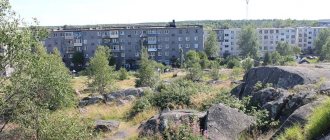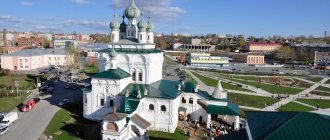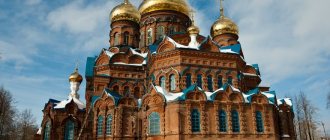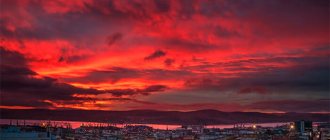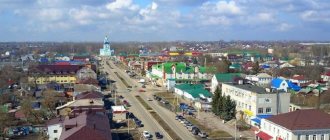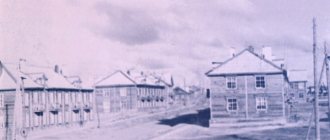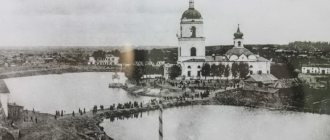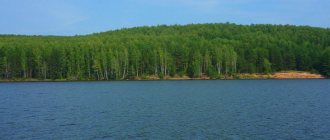You ask, is there life beyond the Arctic Circle? Yes, in the city of Murmansk , the administrative center of the region of the same name. The city is famous for the fact that it is three times the “most”: large, young and warm in the Arctic. And also - Murmansk residents love their city on the Kola Peninsula
- for the unique northern lights and youth
- rough sea and hills,
- special sunsets and sunrises, to
- arctic polar vegetation and the warm Gulf Stream,
- for the kindness and sincerity of the inhabitants of this harsh region.
The city of Murmansk is also famous for the fact that it is the last city where the imperial ambitions of the Romanov dynasty were realized. In 1916, the year of his formation, he was called, although only for a short time, Romanov-on-Murman. It received its modern name just 5 months after the bourgeois revolution.
There were no Bolsheviks in the city until the beginning of 1920 - all this time the northern port was under the rule of the rebellious Admiral Kolchak. A run-of-the-mill, provincial town with handicraftsmen and artisans who catch fish - that’s the entire population of two thousand people. And yet, the 20s became a turning point in the fate of the settlement - it began to develop as a strategic bridgehead-port in the north of the Soviet Union.
The fishing port is growing, and a railway connection with Leningrad has been established. By the beginning of the war there were already 120 thousand people in the city. During the war, the city was subjected to intense bombing, and by the time it ended it was completely destroyed, with the exception of the seaport and three buildings.
The Soviet government included it in the state program for the revival of fifteen cities. 100 million rubles allocated from the state treasury were used for the construction of industrial enterprises, berths along the coast of the Barents Sea, construction of housing and infrastructure. After the construction of their house-building plant, the delivery of housing increased significantly; brick housing construction was replaced with prefabricated panel housing.
Climate of the Kola Peninsula
The proximity of the Barents Sea has a direct impact on the climate of Murmansk, which differs significantly from other cities beyond the Arctic Circle.
In snowy January and February, the average air temperature is -10 °C. Its strong decrease in winter (to approximately – 35 °C) is observed extremely rarely. Warm air masses carried by the North Atlantic Current from time to time provoke thaws in Murmansk, and also delay the onset of cold weather for one month.
The average air temperature in summer is +12-13 °C, sometimes it reaches +25-30 °C. Most precipitation occurs from June to September.
In winter, the sun practically does not appear on the horizon. This phenomenon is called polar night. In summer, on the contrary, the sun does not set beyond the horizon during the day - it is a polar day in Murmansk.
October Revolution, civil war and intervention
In the autumn of 1917 after the October Revolution in Petrograd. On October 27, the Revolutionary Committee was created under the Murmansk Council, headed by the Bolshevik A. Skovorodin. In the following weeks, a unity of actions of Glavnamur (Chief Chief of the Murmansk fortified region and the Murmansk detachment of courts) of K.F. Ketlinsky, the Murmansk Revolutionary Committee, the Council, Tsentromur and the Murmansk Sovzheldor, loyal to the Bolshevik government, developed. However, on January 9, by order of the People's Commissar for Maritime Affairs P.E. Dybenko, Ketlinsky was arrested by Tsentromur. And on January 28, 1918, on the way from Centromur to headquarters, Ketlinsky was killed.
One of the ideologists and organizers of the future anti-Bolshevik coup in Murmansk, in close collaboration with representatives of the Entente, was the chief of staff of Glavnamur, senior lieutenant Georgy Veselago, who returned from Petrograd immediately after the murder of Ketlinsky. On January 30, 1918, he met in Murmansk with the British Consul T.H. Hall and the commander of the British squadron, Rear Admiral T.W. Kemp. In early February, based on Veselago’s proposals, the People’s College of the Murmansk District was established instead of Glavnamur. At the end of February, Rear Admiral Kemp asked the British government to send 6 thousand troops to Murman to protect the port from the possible threat of attacks from Finland.
On March 2, 1918, in Murmansk, at a joint meeting of representatives of the Council of Deputies, Tsentromur, Murmansk Sovzheldor and allied missions, the so-called “verbal, but verbatim recorded agreement on joint actions of the British, French and Russians for the defense of the Murmansk region” was developed. To command the armed forces of the region, an allied military council was established consisting of representatives of England, France and Russia, whose chief of staff was N.I. Zvegintsev. On March 3, 1918, the Brest-Litovsk Treaty was signed, ensuring the exit of the RSFSR from the First World War. On March 6, 1918, a detachment of British marines with guns landed from the battleship Glory, this became the beginning of the intervention. The next day, the English cruiser Cochran appeared in the roadstead, on March 18 - the French cruiser Admiral Ob, and on May 27 - the American cruiser Olympia.
A little history and old name
The construction of a port city beyond the Arctic Circle was planned back in 1870, but work on exploring new places began only 40 years later. In April 1915, a seaport was created on the eastern shore of the Kola Bay along with the small village of Semenovsky.
The main reason for the establishment of the port was Russia's desire to access the Arctic Ocean through an ice-free gulf to ensure the continuous delivery of goods from the Allies during the First World War.
In 1916, the ceremonial foundation of the city took place, named by Nicholas II - Romanov-on-Murman.
After the February Revolution, the city began to be called Murmansk. Until 1920, it was in decline and had no more than 2.5 thousand inhabitants. However, a year later it began to develop rapidly due to the emergence of a strategic need for a large port in the USSR. A significant expansion of the territory of Murmansk occurred in the 70-80s of the last century.
Environmental situation in Murmansk
And now - a balm for the soul of those who cannot sit at home! The ecology in the city of Murmansk is one of the best in Russia:
Reducing air pollution levels. This indicator has been recorded by observers since the beginning of 2000.
- The dust content in the air is below sanitary standards.
- Low radiation level – from 8 microR/hour
- The city's comprehensive pollution index is the lowest in Russia, less than three units.
Pollution rates are decreasing every year.
Ice-free passenger, fishing and commercial port in photos and videos
Murmansk seaport is one of the largest ports in Russia, consisting of three segments: Passenger, Fish, and Trade.
All the country's nuclear icebreakers are assigned to the port, and its annual cargo turnover of incoming ships reaches 60.7 million tons.
Construction of the port began in July 1915, and already in September the steamship Drott, which sailed with cargo from New York, was able to moor at its temporary pier. After the construction of the railway to Kandalaksha, the first trains went to the port.
During the Great Patriotic War, employees of the Murmansk port handled about two million tons of cargo. Currently, the Trade Port of Rybnoye and Passazhirsky is being replaced by the Trade Port, the reason for this is the increase in the export of mineral resources.
The water in the Barents Sea does not freeze even in winter, which is why ships can enter the port all year round.
More facts about the port can be seen in the video:
Attractions
In addition to the Northern Lights, guests of the city can see other attractions, although there are few of them - the city is not even a hundred years old.
The guests examine with curiosity the first Soviet nuclear-powered icebreaker "Lenin", which is laid up in the port. For children, visiting the ship evokes unearthly delight.
A memorial to the defenders of the Soviet Arctic, crowned by the famous Murmansk Alyosha, rises above the city. It is located in the area of Semenovskoye Lake.
The world's northernmost aquarium is also located here. Visitors can see funny performances of marine life from northern latitudes.
Near the lake there is a modern monument associated with the tragic death of the Kursk submarine.
The visiting card of the modern city is the newly built lighthouse and the Church of the Savior on the Waters.
Beautiful nature
The Murmansk region has about 110 thousand lakes with a total area of 10 hectares, as well as more than 18 thousand rivers with a length of 100 m. The city is also famous for its forests, which account for 43% of its total area.
Birch, pine and spruce trees grow on the hills and on the outskirts. Within Murmansk you can find larches, poplars, maples, willows and lindens. Common shrubs include bird cherry, lilac and honeysuckle.
The fauna is represented by bears, lemmings, whales, seals, deer, and arctic foxes. The wooded area and large number of fish ponds attract both resident and migratory birds.
The territory of Murmansk is inhabited by geese, geese, eiders, golden eagles, eagle owls, as well as numerous species of swallows, loons, cranes, larks, etc.
Northern region (1918-1920)
At the end of July 1918, Zvegintsev, together with A.M. Yuryev and V.M. Bramson set off on one of the ships of the intervention squadron to Arkhangelsk to capture the city. There they negotiated with the created Supreme Administration of the Northern Region on the status of the Murmansk Territory. They failed to defend the administrative and economic independence of Murman, and it was included in the Northern Region.
On September 20, 1918, the Supreme Administration of the Northern Region appointed V.V. Ermolov to the post of Special Commissioner for the Administration of Aleksandrovsky and Kemsky Districts of the Arkhangelsk Province (Murmansk Territory). On October 5, 1918, a resolution was adopted “On the abolition of the Murmansk Regional Council and on the restoration of zemstvo self-government in the Kemsky and Aleksandrovsky districts and on the establishment of a temporary position of assistant to the Governor-General of the Northern Region for the management of the Murmansk Territory.” This position was taken by V.V. Ermolov.
In November 1918, the Provisional Government of the Northern Region recognized the supreme power of Admiral Kolchak.
In the fall of 1919, Entente troops were forced to evacuate from Murmansk.
On February 21, 1920, an anti-White Guard uprising took place in the city; Soviet power established itself in the city on March 13 with the arrival of regular units of the Red Army.
Coastal cuisine
In the Arctic, seafood ends up in the kitchen almost immediately after being removed from the water. Among the many types of fish, sea urchin caviar, scallop and shrimp soup, and Kamchatka crab cooked with herbs and peas are considered a special delicacy.
You can try seafood in such popular establishments in Murmansk as:
- "Royal Hunt";
- "Teribersky Coast";
- Restaurant of the Meridian Hotel.
How to get there
Air transport remains the fastest and most convenient way to get to Murmansk. At the same time, the cost of tickets for it is very affordable and is only 1,500 - 2,500 thousand more expensive than a train ticket. For those who do not want to overpay, there is a railway connection. When planning a trip to Murmansk, you need to take into account the weather conditions. It is not uncommon for flights to the city to be canceled due to icing, snow drifts or other bad weather conditions.
By plane
Murmansk Airport receives several daily flights from Moscow and St. Petersburg, as well as a limited number of flights from other cities, including Arkhangelsk, Sochi and Rostov-on-Don. The cost of a flight from Moscow will be about 3,500 rubles, and from St. Petersburg - 4,500 rubles. The airport is located approximately 40 km south of Murmansk, near the city of Murmashi.
A taxi to the city center will take about 40 minutes. Bus number 106 runs from the airport to the railway station, stopping near the Polyarnye Zori hotel along the way. The cost of the bus is cheaper, but travel is much slower than a taxi.
By train
Murmansk can be reached from most Russian cities by train. Moscow is 35-40 hours away, and St. Petersburg is 27-30 hours away, depending on the train. The fastest option is , which also offers first class carriages and an on-board restaurant. All trains stop in cities such as Kandalaksha and Petro src=»https://touristam.com/wp-content/uploads/2019/03/murmansk-5.jpg» class=»aligncenter» width=»600″ height= "450"[/img]
Trains from St. Petersburg and Moscow run daily, most others 2-3 times a week. In summer, additional routes are added, mainly to Ukraine and the Black Sea. On average, the cost of travel from Moscow will be 3,000 rubles, from St. Petersburg - 2,000 rubles. The central railway station is located in the city center on the street. Comintern, 16.
By car
The road to the largest city in the Arctic will take 20 hours from St. Petersburg along the A-121 or P-21 highway. From Moscow, the travel time will be 27-29 hours. You will have to travel either along M-10, and then along R-21 or through Vologda and Vytegra. The last option is more preferable. It is faster in terms of time and comfort, and in cost it will cost, on average, 10,000 rubles.
Famous people
- Nikita Alekseev, hockey player
- Alexey Goman, pop singer
- Katya Grigorieva, supermodel
- Valentina Gunina, chess grandmaster
- Vladimir Konstantinov, hockey player
- Irina Kovalenko, supermodel and Miss Russia winner
- Larisa Kruglova, sprinter
- Sergey Kuryokhin, actor and musician
- Irina Malgina, triathlete
- Elizaveta Nazarenkova, Uzbek rhythmic gymnast
- Evgeny Nikitin, opera singer
- Zlata Ognevich, Ukrainian singer
- Sergei Rozhkov, biathlete
- Alexey Semenov, hockey player
- Sergei Subbotin, former mayor
- Vitaly Zdorovetsky, YouTube Personality, joker
- Yana Kunitskaya, UFC bantamweight fighter
Thirties
Already in 1933, Murmansk became a base for supply and repair of ships of the Northern Fleet. Through him, the construction of the Norilsk Mining and Metallurgical Combine was carried out. The purpose of the port was not limited to military-strategic purposes. The Istria of Murmansk is inseparably linked with fishing. The Soviets were concerned about the increase in production. A port was created on the site of a former defense enterprise for fish processing and ship repair. Subsequently, it quickly developed and after a couple of years it supplied the regions of the USSR with two hundred thousand tons of marine life annually.
During the development of the city, in the early days, wooden sidewalks were laid, and the streets were lined with one- and two-story log buildings. The first brick high-rise building appeared in 1927, which still stands today. The first regular city bus began operating in 1934, running from the northern part to the southern part. And in the same year the Polar Arrow express was launched to Leningrad. The first asphalt street, on which asphalt appeared in 1939, was also named Leningradskaya. Before the war, Murmansk could boast of several dozen multi-story brick buildings and a population of one hundred and forty thousand Murmansk residents. From the twenties until the war itself, the city changed several statuses, due to changes in the state administrative-territorial division: the center of the province, the district within the Leningrad region, and since 1938 it became the center of the region of the same name.
Symbols of the city
Like most cities in the Russian Federation, Murmansk has its own symbols. Approved on November 25, 2004, the main symbol of Murmansk is a rectangular shield with rounded lower corners. The field is divided into two halves, in a ratio of eight to nine. In the upper azure field there is a pennant with multiple vertical stripes, which signify the northern lights. Below it is a golden ship. In the lower yellow sector there is an image of a fish - a symbol of the wealth of the sea that feeds the city. The symbol of Murmansk was first approved back in 1968. It differed from the modern one by the presence of an inscription in Russian “Murmansk”. What about the flag?
Murmansk does not have its own flag at the official level. At festivals and city celebrations, an unofficial blue and white banner with the city's coat of arms in the center is often flown. But there is still no decision from the authorities to recognize it as an official symbol. The flag of Murmansk is sometimes mistakenly called the symbol of the region. Perhaps the issue with the banner will be resolved soon.
Leisure
Winter provides plenty of opportunities for active recreation: skiing, snowmobiling and reindeer, snowball fights for children, downhill skiing. And in the summer you can pick berries, go hiking and admire the modest beauty of northern nature.
Places for active recreation:
- "Fires of Murmansk" - recreation and entertainment park. It is located in a picturesque place where you can spend carefree time with your family. A lot of different activities (rides, fishing, ski slope, catamarans, bungee jumping) will delight everyone who visits this place.
- Snowmobile and ATV tours. Located on Kolsky Avenue. Opening hours: Mon-Fri from 10:00 to 18:00.
- Ski complex "Nord Star". Icebreaker Passage, 10. There is a system for creating artificial snow, which increases the skiing and snowboarding season. On the territory of the complex there is a cozy cafe, a billiard room and an excellent wood-burning sauna.
Popular message topics
- Flowering plants
At the moment in our world, flowering plants, or angiosperms, are a huge group in the modern world of plants. The history of flowering plants is that plants evolved from extinct algae, - Birds
Birds belong to a special class of warm-blooded vertebrates, as they are adapted for flight. This class has other distinctive features: - RAM
When building a PC, you hope for a fast and responsive computer. All components are important, but for now let’s focus our attention on RAM; in the future I will call it RAM, for convenience.
Content
- 1. History
- 2 Administrative and municipal status 2.1 City divisions
- 8.1 Media
- 12.1 Climate
- 13.1 Notes
Transport
Residents of Murmansk often complain about problems with city transport. Due to bad weather conditions and a small population, there is a long wait for public transport. The buses are worn out, and there is simply no metro in the city.
Buses
Murmansk buses are one of the main types of urban passenger transport. It is quite popular along with the trolleybus. Citizens and guests are provided with various city routes, including many intercity ones.
The operating hours of city bus transport depend on the specific route and take place between 5:00 and 00:00. The cost of a single trip is 32 rubles.
Trolleybuses
Trolleybuses run along large large streets, as a rule, they follow the North-South route, but if you need to go to the east, you will have to rely on small minibuses.
Please note that buses and trolleybuses may be delayed during rush hour due to traffic jams. The operating hours of city trolleybus transport depend on the specific route and take place between 5:00 and 00:00. The cost of a single trip is 32 rubles.
Marine boat
Murmansk, whose sights and interesting places are located in hard-to-reach places, is difficult to explore while traveling by public transport.
On the coast of the Kola Peninsula, in points remote from infrastructure, there are hard-to-reach settlements, which are most conveniently reached by the sea vessel “Klavdia Elanskaya”. Departure from Murmansk - once a week. The cost varies depending on the distance of the route and travel conditions, ranging from 30 to 2193 rubles.
Schedule (Q1 2022: every 5th, 12th, 26th month):
| Ports of call | Time | |
| Parish | Departure | |
| Murmansk | 19.00 | |
| Ostrovsky | 12.00 | 18.00 |
| Murmansk | 11.00 | |
Taxi
For those who like comfortable movement around the city, there is a large network of taxi companies in Murmansk: “Vezet”, Maxim, “Taxi Murmansk”, “Yandex Taxi” and many others. Providing transportation services around the clock. The fare starts from 100 rubles.
Don't miss the most popular article in the section: Metro Nizhny Novgorod. Diagram, map, description.
Rent a Car
If you don’t have your own car, you can rent a car from a rental company for a while. In Murmansk there is a wide selection of car rental organizations: “First Auto Rental”, “Rent A Car”, “Car Rental Center” and many others.
Some car rentals operate around the clock, but the majority provide their services from 9-10 am. On average, rental costs start from 500 rubles/hour. But each individual organization has its own specific prices and its own favorable discounts and promotions.
Hotels
The city is small, but it has several comfortable hotels to suit every budget and taste. The most popular among them is the Polyarnye Zori hotel. Tourists like it for its good service and affordable prices.
Hotel "Polyarnye Zori"
Located on the street. Knipovicha, 17 (a few minutes walk up the hill from the Detsky Mir bus stop). Clean, pleasant hotel with helpful reception staff.
On the territory of the hotel there is a swimming pool, restaurant, fitness center, bar. Prices start from 4900 rubles. for a basic single room. The price includes: bathroom in the room, hairdryer, towels, linen, toilet paper.
Congress Hotel Meridian
Located on the street. Vorovskogo, 5/23 (on Five Corners Square). The very center of Murmansk. There is a massage room, restaurant, bar, parking, free Wi-Fi. Rates per night in a standard room start from 4,900 rubles. per day.
The price includes: private bathroom, hairdryer, towels, linen.
Hotel "Lights of Murmansk"
Can be found on the street. Lights of Murmansk, 1. This hotel is located in a ski resort. Excellent view from the windows of the mountain slopes and the city center. The territory has a swimming pool, spa center, restaurant, bar, free parking. The cost per room starts from 5,000 rubles. Guests are offered free access to the water park and sauna for 1.5 hours every day, free ski rental in winter, and boat rental in summer.
Excursions
Snowmobile excursions through the mountains are offered daily. Accompanied by experienced instructors, the group travels through a picturesque glacial valley and Lake Maly Vudyavr. The length of the route is about 25 km. The cost will be 12,900 rubles. for a group of 4 people.
Hunting for the Northern Lights. Conducted daily under the guidance of an experienced guide. The duration of the excursion will be 3-5 hours. The cost of the hunt is 5,500 rubles. per person.
Excursion along the Kola Fjord. The program includes: a visit to the Kola Bridge, the village of Abram-Cape, the village of Mishukovo, the village of Retinskoye, and a picturesque waterfall. The cost of the excursion is 7500 rubles. for a group of 4 people. The duration will be from 4 to 5 hours. It is carried out daily.
After the Victory
After the liberation, the landscape of the city was ruins. Miraculously, the port buildings and only three city buildings survived.
At the end of the autumn of 1945, Murmansk was included in the list of fifteen priority cities for restoration, like Leningrad and Moscow. The port city was allocated one hundred million rubles from the state treasury for development.
In the early 50s, the following were already restored in the city:
- berths;
- enterprises;
- infrastructure;
- even a television complex.
Soon the volume of buildings increased to pre-war levels. The house-building plant, which began operating, began producing panel boxes that were new for that time, from which standard houses appeared in the city. The 70s saw a peak in the expansion of the city's territories, which lasted until the early 80s of the last century.
Kinds of sports
Stroitel Stadium
City association football team, FC Sever Murmansk played in the Russian Second Division until 2014, when it was closed due to financial difficulties.
Bandy club Murman[29] played in the Russian Bandy Super League, most recently in 2011–2012. From 2012 to 2022 they played in the second tier. Russian Bandy Championship, but will again become a Super League team from the 2018–19 season.[30] Their home arena, Stroitel Stadium, seats 5,000 spectators.[31]
The city is one of three places represented in the women's league thanks to the team. Arctic.[32]

